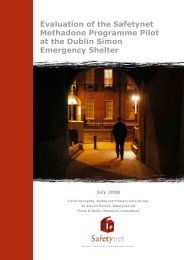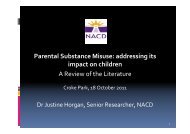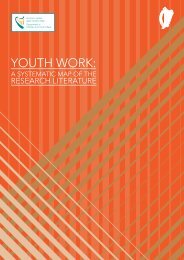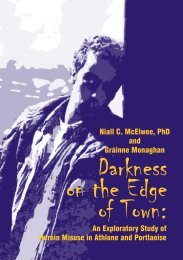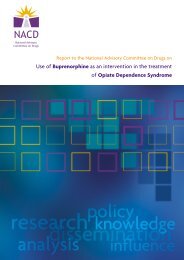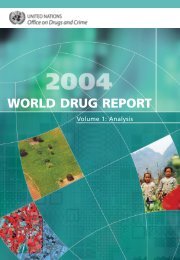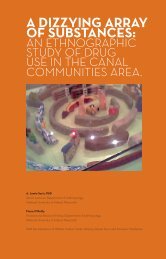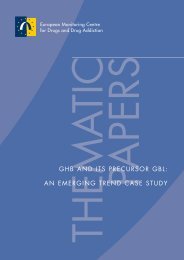Crack cocaine in the Dublin region - Health Research Board
Crack cocaine in the Dublin region - Health Research Board
Crack cocaine in the Dublin region - Health Research Board
Create successful ePaper yourself
Turn your PDF publications into a flip-book with our unique Google optimized e-Paper software.
etween hero<strong>in</strong>, <strong>coca<strong>in</strong>e</strong> and crime. The fourth model views drug-related crime asresult<strong>in</strong>g from a comb<strong>in</strong>ation of <strong>in</strong>fluences or ‘common causes’.Psycho-pharmacological: The l<strong>in</strong>k between drugs and crime arises as a result of<strong>the</strong> psycho-pharmacological properties of <strong>the</strong> drugs <strong>the</strong>mselves. This model proposesthat <strong>the</strong> effects of <strong>in</strong>toxication cause crim<strong>in</strong>al (especially violent) behaviour, or thataggression and crime can be caused by, for example, <strong>the</strong> effects of withdrawal or sleepdeprivation.Economic-compulsive: The economic model assumes that drug users need togenerate illicit <strong>in</strong>come from crimes such as robbery and burglary, and from consensualcrimes such as prostitution, <strong>in</strong> order to support <strong>the</strong>ir drug habit.Systemic: The systemic model expla<strong>in</strong>s drug-related crime as result<strong>in</strong>g from activitiesassociated with <strong>the</strong> illegal drug market. Systemic types of crime surround<strong>in</strong>g drugdistribution <strong>in</strong>clude, for example, fights over organisational and territorial issuesand disputes over transactions or debt collection. Associated third-party violence can<strong>in</strong>clude <strong>in</strong>juries to bystanders. Also <strong>in</strong>cluded <strong>in</strong> this model are drug-related crimes andnuisance and <strong>the</strong> fears of victimisation which can become associated with local drugmarkets.Common cause: The common cause model holds that drug use and crime do nothave a direct causal l<strong>in</strong>k but that <strong>the</strong>y are related because <strong>the</strong>y share common causes.For example, as Hough et al. (2000: 2) suggest, ‘economic deprivation, <strong>in</strong>consistentparent<strong>in</strong>g, low educational achievement and limited employment prospects are riskfactors not only for chaotic or dependent drug use but also for heavy <strong>in</strong>volvement <strong>in</strong>crime’. Drug use can speed up <strong>the</strong> rate of offend<strong>in</strong>g but offend<strong>in</strong>g is not necessarilycaused by drugs, as crim<strong>in</strong>al activity often predates drug use (Pudney 2002).<strong>Crack</strong> use and crimeIn recent years, some US academics have been critical of <strong>the</strong> supposed strong l<strong>in</strong>kbetween crack use and crime, particularly violent crime. Re<strong>in</strong>arman and Lev<strong>in</strong>e(2004) argue that crack-related crime is a function of illicit market systems <strong>in</strong>deprived impoverished areas, and not necessarily a direct consequence of <strong>the</strong> psychopharmacologicalproperties of crack on <strong>the</strong> human bra<strong>in</strong>. Morgan and Zimmer (1997)suggest that, among people predisposed to behav<strong>in</strong>g violently, crack, like any form of<strong>coca<strong>in</strong>e</strong>, may <strong>in</strong>crease <strong>the</strong> likelihood of <strong>the</strong>ir <strong>in</strong>volvement <strong>in</strong> violent episodes. <strong>Research</strong>also suggests that when a person is <strong>in</strong>volved <strong>in</strong> long-term crack <strong>coca<strong>in</strong>e</strong> use, <strong>the</strong>ir<strong>in</strong>volvement <strong>in</strong> crime is likely to escalate and <strong>the</strong>y are more likely to be <strong>in</strong>volved <strong>in</strong>violent crime (Haropocos et al. 2003; Parker and Bottomley 1996; Bra<strong>in</strong> et al. 1998;Gossop et al. 2002).<strong>Crack</strong> <strong>coca<strong>in</strong>e</strong> <strong>in</strong> <strong>the</strong> Dubl<strong>in</strong> <strong>region</strong>: an evidence base for a crack <strong>coca<strong>in</strong>e</strong> strategy69




